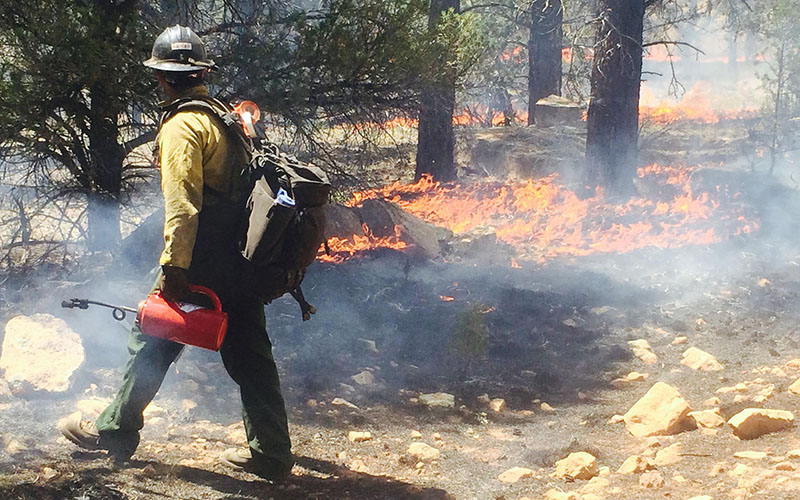
A firefighter keeps an eye on the Rock Fire that broke out July 31 and is burning south of Tusayan. The blaze is expected to continue burning to the northeast over the next fews days. (Photo courtesy U.S. Forest Service)
WASHINGTON – Costs to battle wildfires will consume almost all of the U.S. Forest Service budget in 10 years unless Congress changes the way firefighting efforts are funded, the agency warned Wednesday.
“This year, for the first time, more than 50 percent of the Forest Service’s annual budget will be dedicated to wildfire,” said the report, “The Rising Cost of Wildfire Operations.”
It said that amount was up from 16 percent of the budget in 1995, and it is expected to grow to 67 percent of the agency’s budget by 2025.
See related story:
Fighting fire with fire: Prescribed burns take aim at wildfire threat
By then, the annual cost of fire suppression could hit almost $1.8 billion – about $700 million more than would be budgeted under current formulas. The agency would have to take that money from other programs, “including the very programs and restoration projects that reduce the fire threat,” the report said.
Programs that help prevent fires by maintaining a clean ecosystem, clean forests and clean water are the ones that “ironically get sort of taken away from in order to fight the actual fires,” said Forest Service spokesman Paul Rhynard.
As fire staffing at the Forest Service has risen 114 percent – from 5,700 employees in 1998 to more than 12,000 this year – the number of staffers committed to managing National Forest System lands has fallen 39 percent, the report said.
The agency called on Congress to pass the Wildfire Disaster Funding Act, a bill introduced in January that would let the departments of Interior or Agriculture seek extra funding to fight wildfires instead of having to borrow from other accounts. It would otherwise leave the funding formula unchanged.
“We must treat catastrophic wildfire not like a routine expense, but as the natural disasters they truly are,” Agriculture Secretary Tom Vilsack said Wednesday in a statement with the release of the report.
“It’s time to address the runaway growth of fire suppression at the cost of other critical programs,” Vilsack’s statement said.
Arizona lawmakers were not immediately available for comment on the report Wednesday.
The report said any solution must address both parts of the problem: “It must limit or reverse the runaway growth of firefighting costs, and it must address the compounding disruption of fire transfers.”
Rhynard said that “shifting the source in which we get our funding as opposed to having it transferred from other programs in the Forest Service,” would go a long way to solving the problem.
The report comes as Arizona finds itself in the middle of what has been a fairly quiet wildfire season compared to previous years, said Cathie Schmidlin, a spokeswoman for the Southwestern region of the Forest Service.
Cooler temperatures and higher precipitation in Arizona this summer “has lessened the impact to our forest vegetation … so it lessens the risk of wildfires,” Schmidlin said.
“For instance, of the six national forests in Arizona, only the Tonto National Forest implemented campfire restrictions this year,” Schmidlin said. “That is not typical.”
Of the fires that have broken out this summer, there has not been “much difficulty in suppressing” them, Schmidlin said. Final firefighting costs will not be available until October, but she expects it to be lower than previous years.
While the number of firefighting personnel has expanded nationally, Schmidlin said the number of “firefighting personnel hired in the Southwestern Region has been stable over the last four years.”
She said there are about 500 permanent fire-related employees in the region, which typically adds more than 600 seasonal employees during wildfire season.